ments
Page 4

Altars,
Ballots are in the mail for the most significant election in years. Page 8 WITH VIEWS
Page 5




ments
Page 4

Altars,
Ballots are in the mail for the most significant election in years. Page 8 WITH VIEWS
Page 5



At the time of this writing, Assembly Bill 2580 sits on the governor’s desk awaiting his august signature. AB 2580, as some of you may know from the email blasts received from preservation organizations and neighborhood associations, is a piece of legislation sponsored by CAL YIMBY (an anti-single-family, “yes in my backyard” advocacy group).
The proposed new law would make it mandatory that the Housing Elements of local governments’ General Plans track and analyze all designations of new federal, state or local historic districts — as
well as individual landmarks — for their potential impacts on new housing development.
But what the bill does mostly is frame and stigmatize — as a problem — the preservation movement and the movement’s advocacy for the protection of California historic districts and landmarks.
Our built environment
Preservation is a tool for the management of our built environment; a tool that, like any other, can be misused. We have all heard of the most egregious cases because they tend to make headlines, such as when former City Councilman Paul

Koretz attempted to landmark the LA Burger hamburger stand in 2017 (it was denied). However, these stories also are often more complex than they seem at surface level, and they can lead to interesting compromises where elements of historic structures are preserved or whole buildings are
By Suzan Filipek
The fabled Rindge home at 345 S. Hudson Ave. has topped its own sales record —again.
The home sold for a hefty $21 million in August. The price equals the highest price ever realized in Hancock Park and almost doubles the home’s 2014 sales price. The amount more than doubles its price when it was offered, but not sold, in 2011. Both previous record prices were reported in the Larchmont Chronicle, in September 2014 and December 2011, respectively.
The August 2024 sale at $21 million was off-market
and was completed by listing agent Lisa Hutchins of Coldwell Banker Larchmont.
Sitting on more than an acre within the Hancock Park Historic Preservation Overlay Zone, the 11,336-square-foot home features nine bedrooms and eight bathrooms.
The Mediterranean-style home was designed by architects Koerner & Gage and built in 1926 for the family of Samuel Rindge, a landowner, banker and real estate developer.
He was a partner in the Rindge Company, which had extensive holdings in Malibu.
The company oversaw management of the estate of his father, Frederick H. Rindge, one of the last Spanish land grant owners in Southern California and owner of Rancho Malibu.
Actor David Schwimmer, who played Ross on the sitcom “Friends,” purchased the Hudson Avenue house in 2001 for $5.6 million.
The home at the time featured a step-down living room, wood-paneled library, screening room, formal dining room, four fireplaces and hardwood floors. The grounds feature fountains, pool and
integrated into new projects.
But, with barely seven percent of the land in Los Angeles deemed historic, the existing SB 330 already preventing the establishment of new HPOZs (Historic Preservation Overlay Zones), the current availability of only lesser protections from National Register and California Register designations, and the complicated bureaucratic process of getting individual properties listed … preservation is a pretty weak tool to use to prevent development.
To YIMBYs, however, the problem is not that it is a weak
tool but that it might be used to stop ANY development at all. Brian Hanlon, CEO of CAL YIMBY, admitted as much: “California’s unique history and historical architecture are worth protecting, but the preservation process is often abused by parties who simply want to prevent the construction of new homes.” He sees AB 2580 as a “critical first step toward identifying how historic preservation ordinances are being used across our state, and helping regulators keep track of instances when they reduce local housing capacity.”
(Please turn to Page 3)
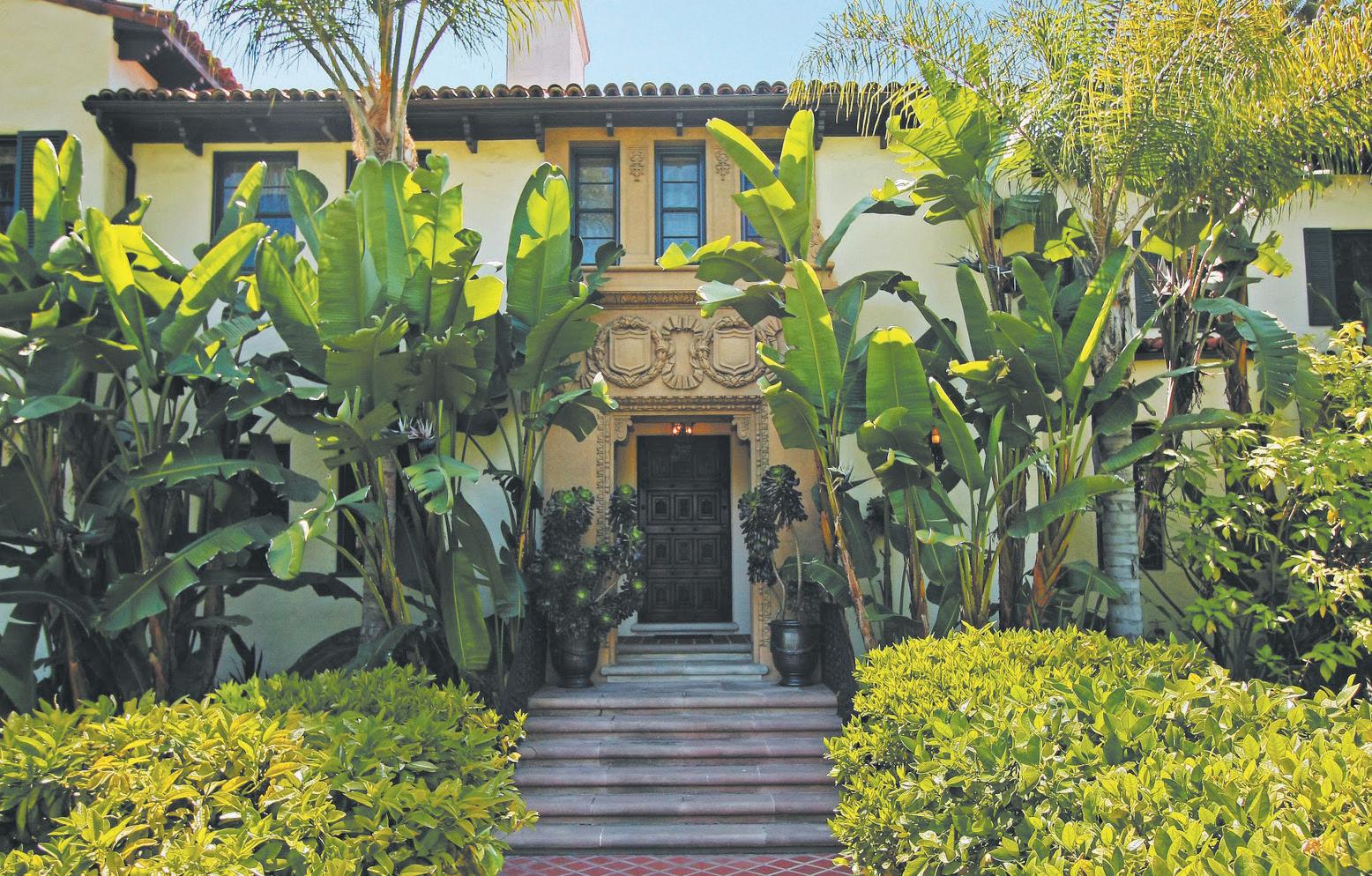
spa, tennis court and a guest apartment over the three-car garage. When the property changed
hands again in 2014 and transferred to the recent transaction’s seller, the sales price was $11 million.

By Suzan Filipek
The Los Angeles City Planning Commission unanimously approved last month a slightly trimmer version of a major real estate development project proposed at the former CBS TV studio at Beverly Boulevard and Fairfax Avenue.
The 1.7 millionsquarefoot TVC 2050 Project next goes before the City Planning and Land Use Management (PLUM) Committee and then City Council for a final vote.
Representatives of nine appellants of the City Planning Department staff recommendation were among speakers at the nearly sixhour hearing
(Continued from Page 2)
The second step? That most likely would be attempts to defang local ordinances that prevent demolition of historic properties or to enact new limits on what can be deemed worthy of preservation. A developer’s dreamland!
800 Lorraine
Greater Wilshire is currently a flashpoint in this debate in the City of Los Angeles because of the proposed Executive Directive 1 (ED1) project at 800
held in City Hall’s John Ferraro Council Chambers and on Zoom on Sept. 12.
The Commission also heard from area residents, business owners and union members speaking for and against the development.
Yaroslavsky letter
The size and scope of the proposed project were trimmed in response to requests made by City Council District 5 Councilwoman
Katy Yaroslavsky in a letter read by her planning director at the hearing. Among the Commissionadopted modifications is one to require the TVC 2050 developer to prioritize entertainmentre
Lorraine Blvd., which falls within the Windsor Village HPOZ. Filing of an application for this sixstory development next to an historic singlefamily home stimulated Fifth District City Councilwoman Katy Yaroslavsky to submit a City Council motion, which later passed, to exclude all HPOZs and historic districts from ED1 projects.
YIMBYs were furious at this move — falling back on their most petty weapons by hurling epithets such as “exclusionary,” “segregationist,” “racist,”
lated uses for the additional halfmillion square feet of new general office space approved by the staff and Commission.
The project’s proposed Specific Plan was a stumbling block for many as it was considered vague and lacking transparency.
Appellants included the owners of the Original Farmers Market and The Grove, plus other neighbors of the development and community groups.
Opposition continues
In a Sept. 13 posthearing email statement, cochairs of appellant Neighbors for Responsible TVC Develop
(Please turn to Page 6)
— despite HPOZs being shown to be among the most ethnically diverse enclaves in the city. Yet, 800 Lorraine was given the city’s green light. It now is the subject of legal challenge from neighbors.
Heritage so rich
If Gov. Newsom would just understand that AB 2580 is nothing more than a “make work” bill that adds to the tasks of local planning departments in putting together their Housing Elements, he would veto it as an affront to the legacy of the multitude that has fought
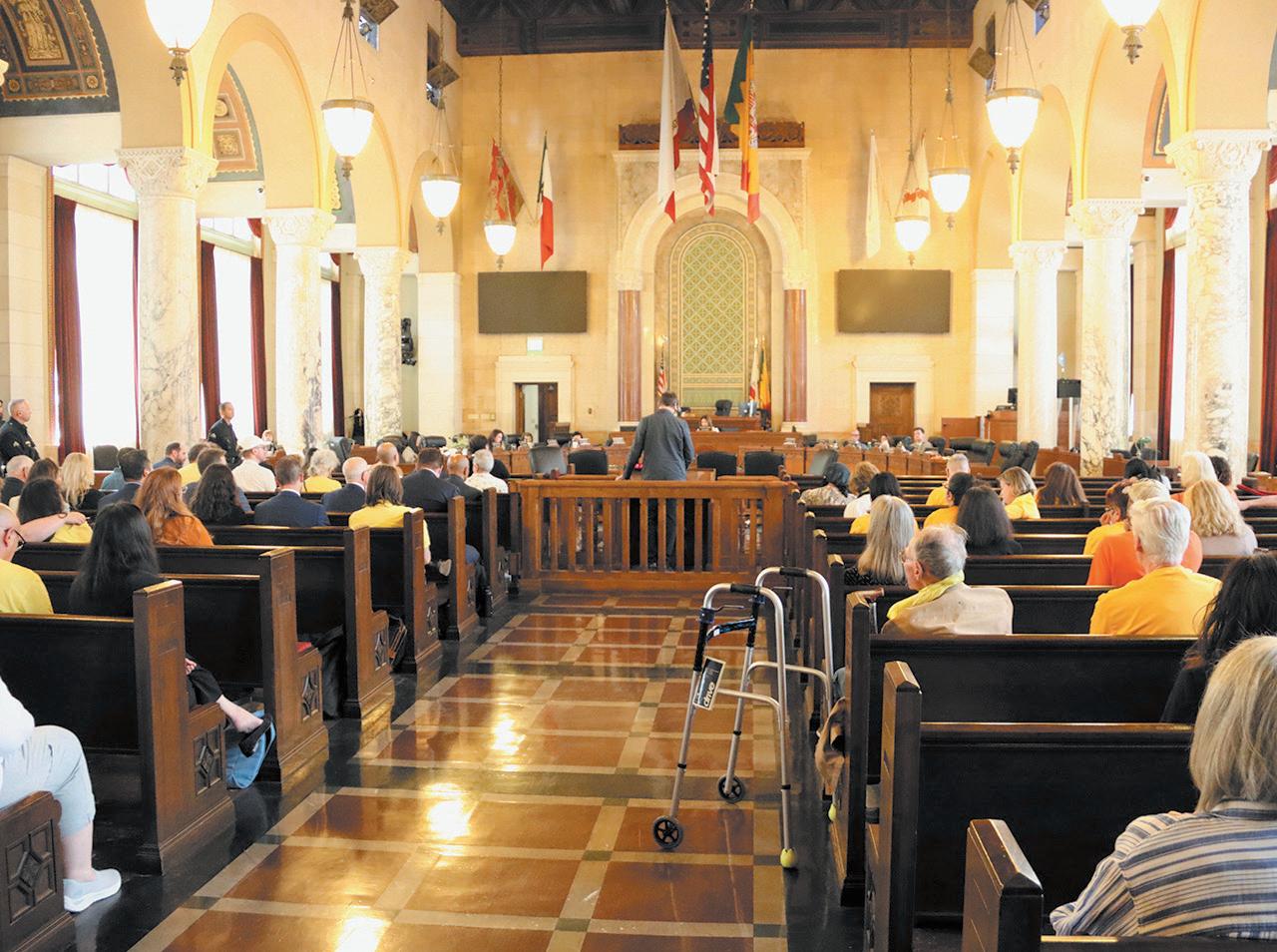
to protect and defend the California historic resources that underpin our state’s history, culture and community sense of place. He would see how — in Downtown Los Angeles, Hollywood and the Miracle Mile — historic commercial buildings have been converted to residential use through adaptive reuse … and have brought increases in the housing supply. Understanding that, the governor might even sponsor greater incentives for reusing historic buildings as a “green solution” to housing.
I would hope Gov. Newsom can understand preservation as it was framed in one of the founding documents of the American historic preservation movement — the book “With Heritage So Rich,” which explains that historic preservation is a force to give “a sense of orientation to our society, using structures and objects of the past to establish values of time and place.”
However, and sadly, with respect to the governor vetoing AB 2580, I’m not holding my breath.

By John Welborne
In late September, the owner of the three-story Brookside office building at 4750 Wilshire Blvd. announced it had completed the conversion of the top two floors of the building into 68 luxury apartment residences. Leasing has commenced.
Construction took about two years. The Los Angeles Department of City Planning approved the project in July 2022, after about one year of review. The subsequent short (for Los Angeles) construction period clearly demonstrates an advantage in adapting existing buildings to needed new residential uses. Architects for the residential conversion are KFA Architects in Culver City.
Park Mile location
The building is located on Wilshire Boulevard, within the Park Mile Specific Plan area at the northern edge of the historic Brookside single-family community — between Hudson and Keniston avenues. The views from apartment windows are of Hancock Park to the north, Miracle Mile to the west, the towers of Downtown Los Angeles to the east, and Brookside’s homes and trees to the south.
Free garage parking
The project, which features an abundance of existing parking from its original use as the information technology headquarters for Farmers Insurance Company, provides two free garage parking spaces with each unit. There also is ample guest parking. (Plus, for bicycles, there is on-site short-term and long-term storage available.) In addition, the project includes the usual amenities of a modern, luxury apartment building. There are a landscaped outdoor courtyard, lap pool, fitness center, lounge with games tables and a children’s playroom, TV / movie room and more. The ground floor mail and storage facilities adjoin a pet-washing room for furry friends.
The coworking lounge has communal worktables and enclosed offices. Perhaps the building’s greatest luxury is its location in an historic, low-density area with an established tree canopy and abundant light and open air all around the building.
The building does retain approximately 30,000 square feet of ground floor creative office space, which is 100 percent leased as of September 2024. The office space will maintain the address of 4750

Wilshire Blvd. while the apartments will have the address of 701 S. Hudson Ave.
Nine floor plans
The residences have nine different floor plans, for studio, one- and two-bedroom units. Some units offer a den that can function as a home office or additional living space. Units feature 8-foot doors and 10-foot ceilings and substantial window glass for each residence. There are
(Please turn to Page 6)


By Casey Russell
The 25th Día de Los Muertos at Hollywood Forever cemetery, 6000 Santa Monica Blvd., will take place Sat., Oct. 26, from 10 a.m. to midnight.
More than 100 breathtaking altars, some embodying this year’s theme, “Spirit Guides and GuarDíans,” will be viewable throughout the grounds during the all-day event. The celebration will also feature a children’s plaza and stage, multiple adult stages (one erected in the cemetery’s lake) for dance and other performances, arts and crafts and food vendors.
Highlights of the event are the costume and altar contests. Participants go all out with costumes. The firstplace winner receives $1,000 and the runner-up wins $500.
Awards for best traditional altar, best contemporary altar and best altar related to this year’s theme will also be presented at 8 p.m. Entrants can sign up at ladayofthedead. com. Altar contest winners will receive $5,000 per category.
“The sharing by the living is core to the altar tradition,” said Tyler Cassidy, co-owner of Hollywood Forever and a resident of Windsor Square.
“I find that a lot of the experience of the altars, for the creators, is taking visitors through while explaining about the altars and those they honor,” he said.
When asked how the event began, Cassidy told us, “We started this event 25 years ago because the cemetery, at that time, had not been particularly welcoming to Latinos.”
Co-owners Yogu Kanthiah and Cassidy bought the nearly bankrupt cemetery in 1998.
Realizing that not all potential clients were choosing Hollywood Forever, the duo worked to open it up for more business and to ensure that Latinos had a place in which their traditions could live on.
“Our goal was to invite our community in to celebrate their traditions, and in doing so, offer to serve them, “ he said.
A cemetery employee at the time, Daisy Marquez, brought the idea of a Día de Los Muertos (Day of the Dead) celebration to the owners. “Her idea corresponded with what we knew the cemetery needed. It needed to be reborn as a place of memory,” said Cassidy, whose father is buried there. Cassidy includes his father in the cemetery’s smaller, Sat., Nov. 2, Día de Los Muer-

tos celebration that is open only to those with loved ones buried at Hollywood Forever (and that is conducted entirely in Spanish). “It means a lot to me to give him a day with everyone else. It’s not so lonely,” said the co-owner.
Cassidy’s favorite section of the Oct. 26 community Día de Los Muertos event is the lake stage, which will stand temporarily in the middle of the lake and is dedicated to Mexican Pre-Colonial dances. “It’s beautiful at night,” he said.
Tickets to the celebration start at $53.60, with VIP tick-
ets available for those who want access to lakeside VIP Oasis lounge seating, a private raised viewing area with access to premium food, beverage and face-painting vendors. There are three windows of admission: 10 a.m to 2 p.m., 2 p.m. to 6 p.m. and 6 p.m. to 11 p.m. Attendees are able to stay beyond their window of admission.
For more information, visit ladayofthedead.com.


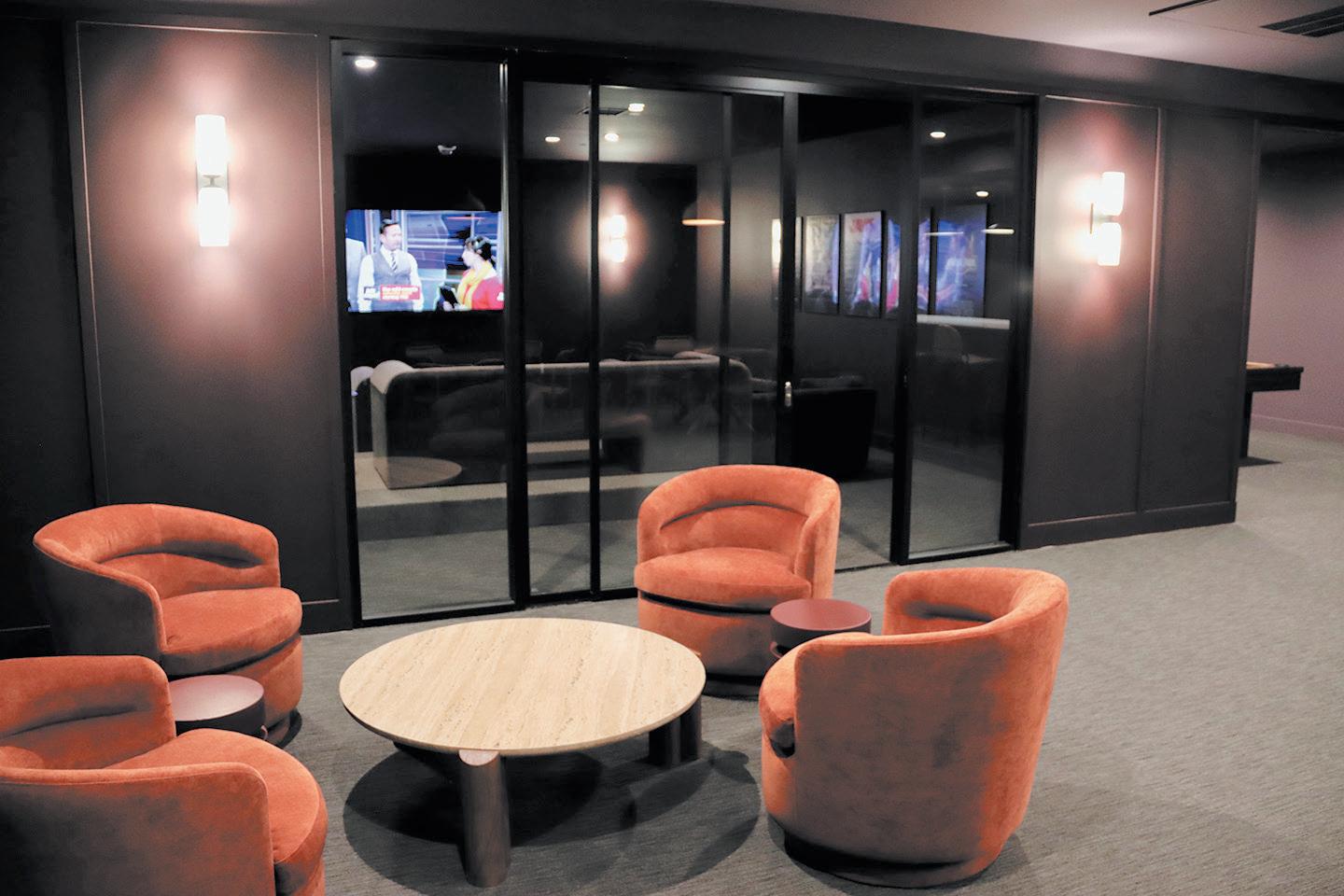
(Continued from Page 4)
screened, operating windows, but each unit also has its own central air conditioning with high efficiency heat pump.
Inside the units, many with walk-in closets for the bedrooms, residents will find
HPHOA annual meeting Oct. 21 is on Zoom
Councilperson Katy Yaroslavsky from District 5, along with the area’s LAPD senior lead officer, are expected to attend the annual meeting of Hancock Park Homeowners Association on Mon., Oct. 21 at 6 p.m. on Zoom.
Hear from HPHOA committees on safety and security, parkway trees, neighborhood filming and repairing streets and sidewalks. Updating your home in a Historic Preservation Overlay Zone also will be discussed.
Check the website closer to the time for a full agenda and for the Zoom link, at hancockparkhomeownersassociation. org.
wood flooring and modern, high-end fixtures, including stone counters, sleek cabinetry and a washer and dryer in each unit. A few units have private, outdoor patios adjoining the main courtyard, and a few two-bedroom, twobath units have an additional powder room.
(Continued from Page 3) ment wrote, “We are deeply disappointed that our Councilmember Katy Yaroslavsky and the Los Angeles City Planning Commission prioritized speculative development over the community’s reasonable requests for changes that would produce a successful studio compatible with our neighborhood…
“While the TVC 2050 developer promotes the project as a studio, in reality they are asking the City for a blank check approval for many types of potential uses, a massive increase in square footage, and up to 20 years of phased construction, all subject to minimal public review.
“In recent months, more


As a luxury building in an exceptionally desirable, city-center residential neighborhood, the 701 Hudson monthly rents reflect the location, values and amenities offered. However, for those responding early, the owner is offering free rent for up to eight weeks for some
than 2,200 local residents signed petitions against the project, and after the Draft EIR was published, more than 450 residents, community organizations and businesses submitted letters to the Planning Department opposing the project.”
City Planner Paul Caporaso, when asked what the timeline would be going forward, told the Chronicle, “The dates for PLUM and City Council have not been scheduled at this time. We will issue a Letter of Determination in the coming weeks that will provide details on the Commission’s decisions on the Project at last week’s meeting.”
Bake sale Oct. 26
Homemade baked goods and used books will be available for sale Sat., Oct. 26, from 11 a.m. to 3 p.m., at Wilshire Library, 149 N. St. Andrews Place.
FAIRFAX
161 S. Gardner St. 323-936-6191
JOHN C. FREMONT 6121 Melrose Ave. 323-962-3521
MEMORIAL
4625 W. Olympic Blvd. 323-938-2732
WILSHIRE
149 N. St. Andrews Pl. 323-957-4550
HOURS
Mon. and Wed., 10 a.m. to 8 p.m.; Tues. and Thurs. noon to 8 p.m.; Fri. and Sat., 9:30 a.m. to 5:30 p.m. Libraries will be closed Mon., Oct. 14 in observance of Indigenous Peoples’ Day.
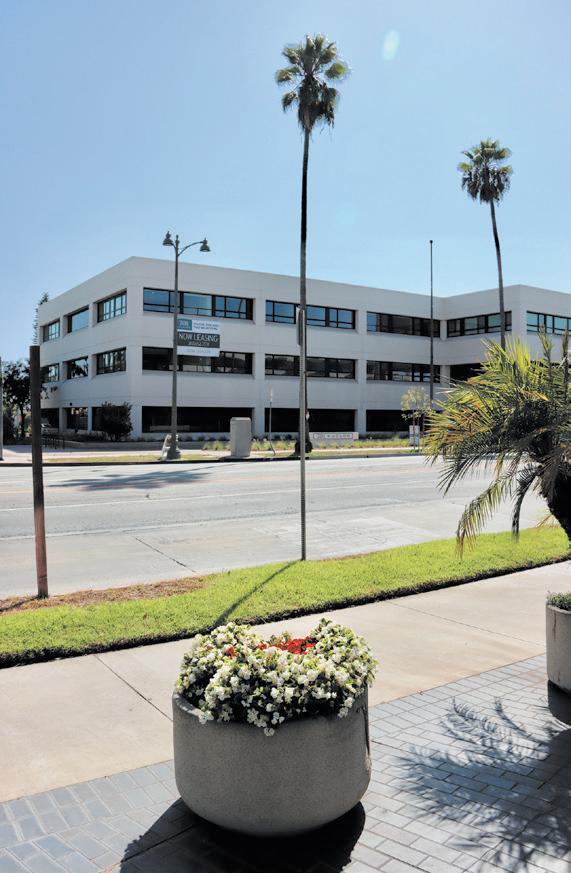
units. Monthly rents vary from $2,999 for an approximately 522-square-foot studio up to $8,824 for one of the four two-bedroom, two-bath units of approximately 1,768 square feet each.
The property owner is Creative Media & Community Trust Corporation, a real estate investment trust led by CIM Group, which has its headquarters next door at 4700 Wilshire Blvd. CIM has been the longtime proponent
of the adaptive reuse of the Farmers Insurance Tower and the construction of new, Park Mile Specific Plan-compliant residences on various surface parking lots surrounding the historic Farmers properties. Learn more about 701 Hudson, including leasing information, at 701shudson.com.


By Suzan Filipek
Voting has never been easier. Ballots for the Tues., Nov. 5, General Election will be mailed by Mon., Oct. 7 to all registered voters, and ballot boxes will open by Oct. 7.
Ballot drop-off locations open on Tues., Oct. 8.
Vote-by-mail ballots can be returned by mail at a dropoff location or your county elections office. They must be postmarked on or before Election Day and received by Nov. 12.
Walk-in Vote Centers will be open Sat., Oct. 26, through Election Day, Nov. 5. A list of locations will be available 3040 days before the election.
The last day to register to vote for the Nov. 5 election is Mon., Oct. 21.
Choosing is not as easy
Choosing among the varied candidates and bonds and other ballot measures is the trickier part. Residents will have a number of candidates and county, city and state measures on their ballot.
On the ballot will be the largest bond put forth by the Los Angeles Unified School District, $9 billion for new school construction.
Contentious races
For local readers, the most interesting and contentious races probably are two — the U.S. Congress 30th District seat long held by U.S. Rep. Adam Schiff (now running for U.S. Senate) and the Los Angeles County District At-
torney race, where Nathan Hochman is challenging incumbent George Gascón. Some Larchmont Chronicle readers also get to vote for a city councilmember for Council District 10. And, of course, there is a U.S. President election.
United States Senate
Former Major League Baseball player and Dodger first baseman Steve Garvey is the underdog in the United States Senate race against former longtime Congressman Adam Schiff
If elected, Garvey would call for a federal audit of billions of dollars “wasted on California’s homelessness crisis,” Garvey wrote on X. Schiff served the 30th Congressional District and as a California State Senator. Issues on his agenda include gun violence prevention, climate change, criminal justice reform, housing and homelessness.
Congressional Districts
In the race to succeed Adam Schiff in Congressional District 30, California State Assemblymember Laura Friedman faces Dr. Alex Balekian
Adjoining the 30th District are Districts 34 and 37. Both have incumbents.
U.S. Representative Jimmy Gomez is running again in Congressional District 34 against David Kim, a children’s court attorney.
U.S. Representative Sydney

Kamlager-Dove is running again in Congressional District 37 against Juan Rey , a train mechanic.
State Assembly
In the State Assembly, incumbent Rick Chavez-Zbur (Assembly District 51) faces entrepreneur Stephan Hohil, and Isaac Bryan (Assembly District 55) faces Keith G. Cascio, a software developer.
In the 54th Assembly District, which includes a bit of the eastern portion of the Greater Wilshire Neighborhood Council area, there is no incumbent, and Mark Gonzalez, district director to Assemblyman Miguel Santiago, squares off against John K. Yi, a public transit advocate.
City Council District 10
The only local Los Angeles City Council contest (even-numbered council districts this time) is for CD 10, along the southern and eastern borders of the Larchmont Chronicle readership area.
Running as the incumbent in this nonpartisan race is Heather Hutt, the appointed replacement for her convicted predecessor, Mark Ridley-Thomas. Hutt faces attorney and Neighborhood Councilmember Grace Yoo. Los Angeles County District Attorney
Perhaps the most watched and most contentious race is the one for the nonpartisan position of Los Angeles County District Attorney.
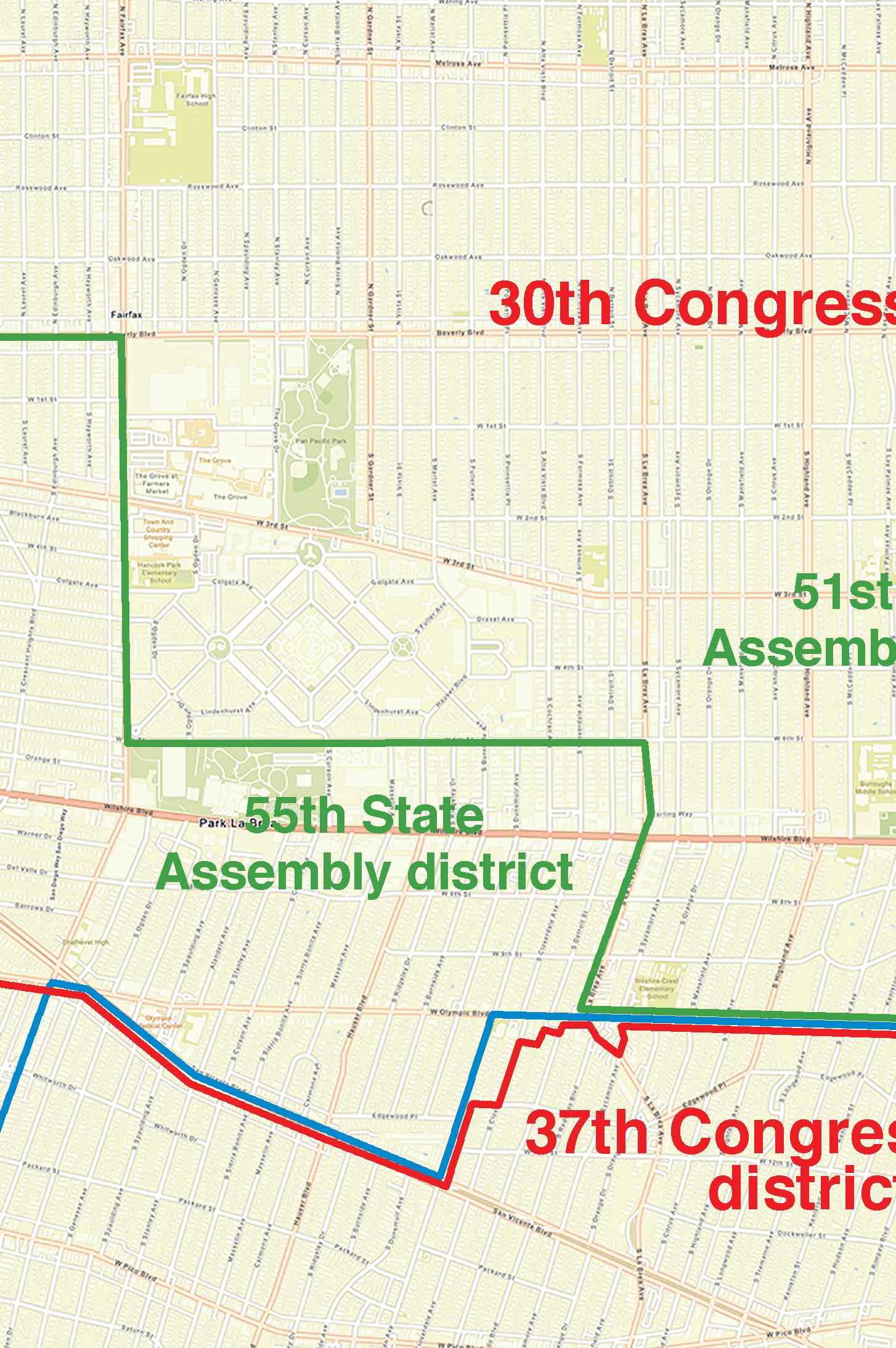





Incumbent George Gascón is running against former prosecutor and criminal defense lawyer Nathan Hochman. According to LAist, the election is “expected to be closely watched across the country as a barometer of how the public is feeling about criminal justice reforms amid an increase in property crime. Property crime is up 17.4 percent in the city of Los Angeles so far this year compared to two years ago... Violent crime is down 1.3 percent year-todate from two years ago.” Los Angeles County Measures
There are three Los Angeles County Measures on the ballot. Each requires a majority vote of 50 percent+1.
Measure G would amend the Los Angeles County Charter to create a County Executive person to be elected at-large throughout the county. It also would create an independent Ethics Commission to restrict lobbying and investigate misconduct. Further, Measure G would increase the Board of Supervisors from five elected members to nine elected members and make other changes. Opponents include Supervisors Holly Mitchell and Kathryn Barger, the LA County Firefighters & Sheriffs and the Community Coalition.
Measure A: Named the Homelessness Services and Afford-
able Housing Ordinance, this county measure is intended to create affordable housing, support home ownership and provide rental assistance as well as increase mental health and addiction treatment, among other services. If approved, it would replace the existing quarter-cent sales tax, under Measure H, which expires in 2027, with a new half-cent sales tax indefinitely. It would raise an estimated $1.1 billion yearly. Supporters include Habitat for Humanity of Greater Los Angeles and Women’s & Children’s Crisis Shelter. Opponents include Howard Jarvis Taxpayers Association, former County Supervisor Mike Antonovich and Jack Humphreville.
Measure E is the Consolidated Fire Protection, Emergency Response and Infrastructure Ordinance. It addresses firefighter and paramedic response times and pays for upgraded equipment by levying property tax of six cents per square foot of parcel improvements, providing $152 million annually, within limits and subject to exemptions. Firefighter groups support; Howard Jarvis Taxpayers Association, former County Supervisor Mike Antonovich and Jack Humphreville oppose. For information on the measures. visit tinyurl. com/3xjw3t4v.

By Suzan Filipek
Seven Los Angeles City measures are on the ballot, and all but one require a majority vote of 50 percent+1 to pass. The $9 billion school bond, Measure US, requires a 55 percent majority to pass.
Measure DD would create an independent redistricting commission to redraw the City Council district lines every 10 years.
identity in non-discrimination rules, clarify the Airport Commission’s authority to establish fees and make other changes.
For LAUSD
Measure LL would amend the City Charter to establish an independent redistricting commission to redraw Board of Education district lines every 10 years in the Los Angeles Unified School District.
Measure HH would amend the City Charter to require that commission appointees file financial disclosures, clarify the Controller’s auditing authority and expand the City Attorney’s subpoena power, among other changes.
Measure II would amend the City Charter to clarify that El Pueblo Monument and the Los Angeles Zoo are park property, include gender
Measure ER would amend the City Charter to establish a minimum annual budget for the City Ethics Commission and increase its authority over spending decisions and hiring. It would also require the City Council to hold a public hearing on Commission proposals and increase penalties for violations of City laws.
Measure FF would amend the City Charter to allow peace officers employed by the Police, Airport, Harbor and Recreation and Parks Departments to transfer membership and service to the Los Angeles Fire and Police Pension Plan.
Learn more about city Measures DD through FF at tinyurl.com/yc7pnh2k.
Measure US would authorize $9 billion in bonds to update school facilities. US requires 55 percent of the votes to pass.
This is the largest bond put on the ballot by the Los Angeles Unified School District. Property taxes would rise about $273 a year for a median-priced ($1 million) home within the school district, according to the Howard Jarvis Taxpayers Association, which opposes, along with former County Supervisor Mike Antonovich and Jack Humphreville. Supporters include Families in Schools.
Learn more at tinyurl. com/3xjw3t4v.
State: Ten measures, including two big bonds
By Suzan Filipek
If the 10 state measures on the Tues., Nov. 5, ballot pass, marriage would become a constitutional right, and the minimum wage would be raised to the highest in the country.
Providing funds for schools and affordable housing are also in the mix.
Read below for a synopsis of each measure:
Prop. 2 would authorize $10 billion in bonds to repair, upgrade and construct new facilities at K-12 public
(Please turn to Page 10)

(Continued from Page 9) schools, community colleges and career technical education programs. California Teachers Association is among the proponents, while the Howard Jarvis Taxpayers Association opposes.
Prop. 3 would amend the state Constitution to recognize the right to marry, regardless of sex or race.
Prop. 4 authorizes $10 billion in bonds to fund various programs promoted as addressing climate risks. Clean Water Action supports; Howard Jarvis Taxpayers Association opposes.
Prop. 5 would lower voter-approval requirements for local bonds for affordable housing and public infrastructure including
road and transit expansions, parks and more. The measure proposes 55 percent voter approval, rather than the current two-thirds approval required by the state’s Constitution.
League of Women Voters of Calif. supports; California Taxpayers Association opposes.
Prop. 6 removes a state Constitutional provision that allows incarcerated persons to be forced to work. If passed, prisoners could voluntarily accept work assignments in exchange for credit to reduce their sentences.
Prop. 32: If passed, all workers would make at least $18 an hour by 2026. The measure reads: “For employers with 26 or more employees, to $17 immediately, $18 on Jan. 1, 2025. For employers with 25 or fewer employees, to $17 on Jan. 1,
2025, $18 on January 1, 2026.” California Chamber of Commerce and others oppose.
Prop. 33 expands local government’s authority to enact rent control on residential property and would eliminate the Costa-Hawkins Rental Housing Act of 1995, which allows landlords limited market-rate increases. AIDS Healthcare Foundation is sponsoring the measure; opponents in the real estate industry say it is anti-housing. Learn more at yeson33.org and NoOnProp33.com.
Prop. 34 restricts spending of prescription drug revenues by some healthcare providers, with the primary object being to deter the AIDS Healthcare Foundation from spending such revenues on ballot measure campaigns. The California Apartment Assoc. supports; the AIDS Healthcare Foundation opposes.
Prop. 35 provides permanent funding for Medi-Cal health care services set to expire in 2026. Chair of the American Academy of Pediatrics is among supporters. No argument against was provided.
Prop. 36 allows felony charges for, and increases sentences for, certain drug and theft crimes under $950 — both currently chargeable only as misdemeanors — for crimi-

nals with prior convictions. For arguments for and against the state propositions, visit the California Secretary of State Voter Information Guide at tinyurl. com/344763pt.
Sources of voting recommendations include our town’s two major daily newspapers. Go to: dailynews. com/opinion/endorsements and, for the Los Angeles Times, tinyurl.com/ytd4v9u4.
By John Welborne
At the new location of the popular Andre’s Italian Restaurant — on the ground floor of the historic Dominquez Wilshire Building (1930) at Wilshire and Cloverdale — about 30 interested neighbors gathered for morning coffee on Sat., Sept. 21. They were invited by Walter N. Marks III, whose company is preparing to build a new high-rise, mixed-use tower, primarily for housing. Marks and his family have been Miracle Mile property owners for more than five decades.

The project, which includes restoring the two historic Art Deco façades on the corner of Cloverdale (the former Sontag Drugs building) to enclose a new restaurant, has a Draft Environmental Impact Report circulating for comment.




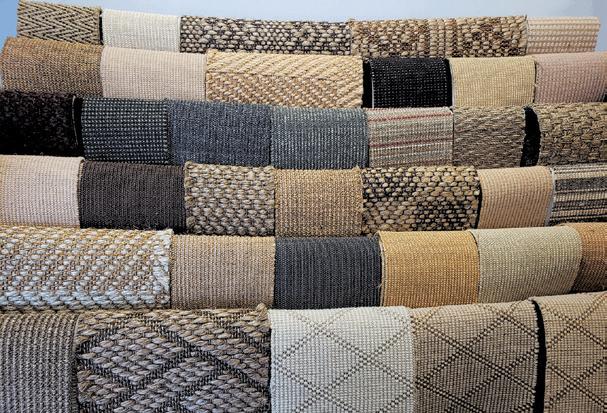


By Helene Seifer
Where once visitors to The Grove dined on garlic bread and rigatoni, the former site of Maggiano’s Little Italy is now serving up dining tables, couches and hand-hewn chandeliers. The former restaurant has been completely rebuilt and redesigned into a light and airy 17,904square-foot showcase for the upscale furniture and lifestyle brand Arhaus. This store, one of 13 California locations of more than 100 stores nationwide, displays a rotating selection of hundreds of pieces for the home, including outdoor collections displayed on two patio areas to better highlight the nice weather of Southern California.
The furniture and décor company has often been met with success by settling in high-end shopping areas, including its original California location at Del Amo Fashion Center in Torrance, where it opened in 2017. Therefore, opening at The Grove makes sense. Hannah Wickberg, associate director of public relations and experiential marketing at Arhaus, states, “Arhaus blends seamlessly with the Grove’s high-end boutiques, shops, restaurants and entertainment offerings.”
Named after the German word haus, for “house,”

Arhaus CEO John Reed co-founded the brand with his father in 1986, opening the first showroom in Cleveland, Ohio, near Boston Heights, where the company is based. Arhaus is committed to sustainable practices and craftsmanship. The Reeds and their teams have developed relationships with artisans around the world and feature them on the blog Unabridged. Textiles are woven and hand-finished in an ancient mill near Lake Como, Italy. Florentine metal workers sculpt lighting fixtures. Artisans in India weave wool and cotton rugs. Woodworkers in Mexico shape tables. Upholstered collections are made in North Carolina, the center of furniture making in the
United States. The aim is to make beautiful, high-quality products that last and are suitable for all sizes and styles of homes. The pieces are artfully displayed in home-like groupings against a backdrop of giant windows and accent walls that are deeply hued or color washed.
Store Manager Rod Martinez reports that the Arhaus Kipton collection of upholstered furniture is one of the biggest sellers nationwide, including locally. The ribbed Finley tables, consoles and bedroom sets, which conjure up old Hollywood, are popular here. “For a while, everything was neutrals,” says Martinez. “Now we’re going back to patterns and rich textiles that look like wallpaper,” a look that patrons of the Grove store have embraced.
The retailer’s upholstered furniture is customizable with different fabrics, finishes and sizes. Additionally, the Arhaus designers have specifically responded to the perceived desires of the population surrounding their Grove showroom. Wickberg explains, “We have developed many custom, statement pieces for this location knowing the L.A. market’s appetite for bespoke,

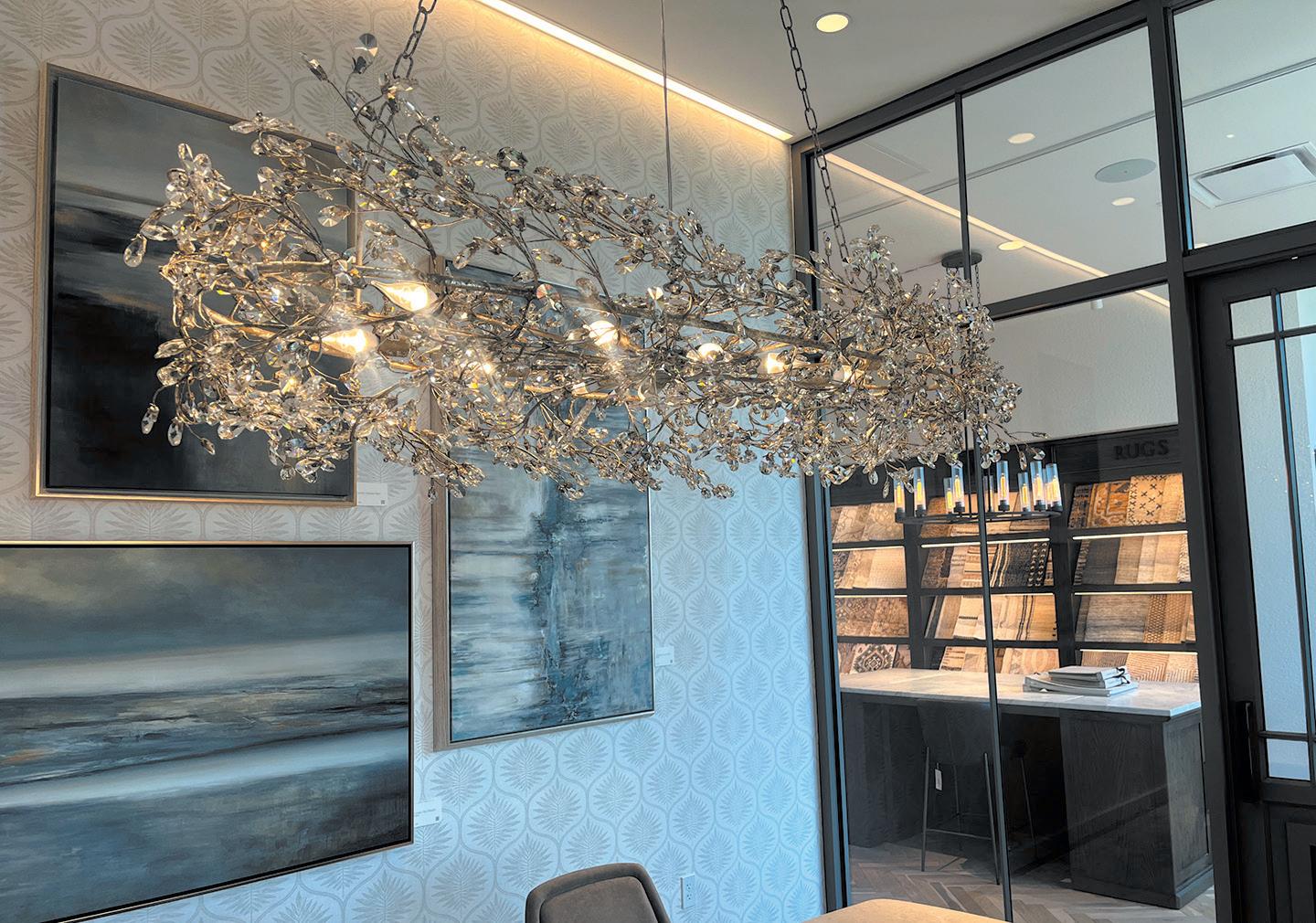
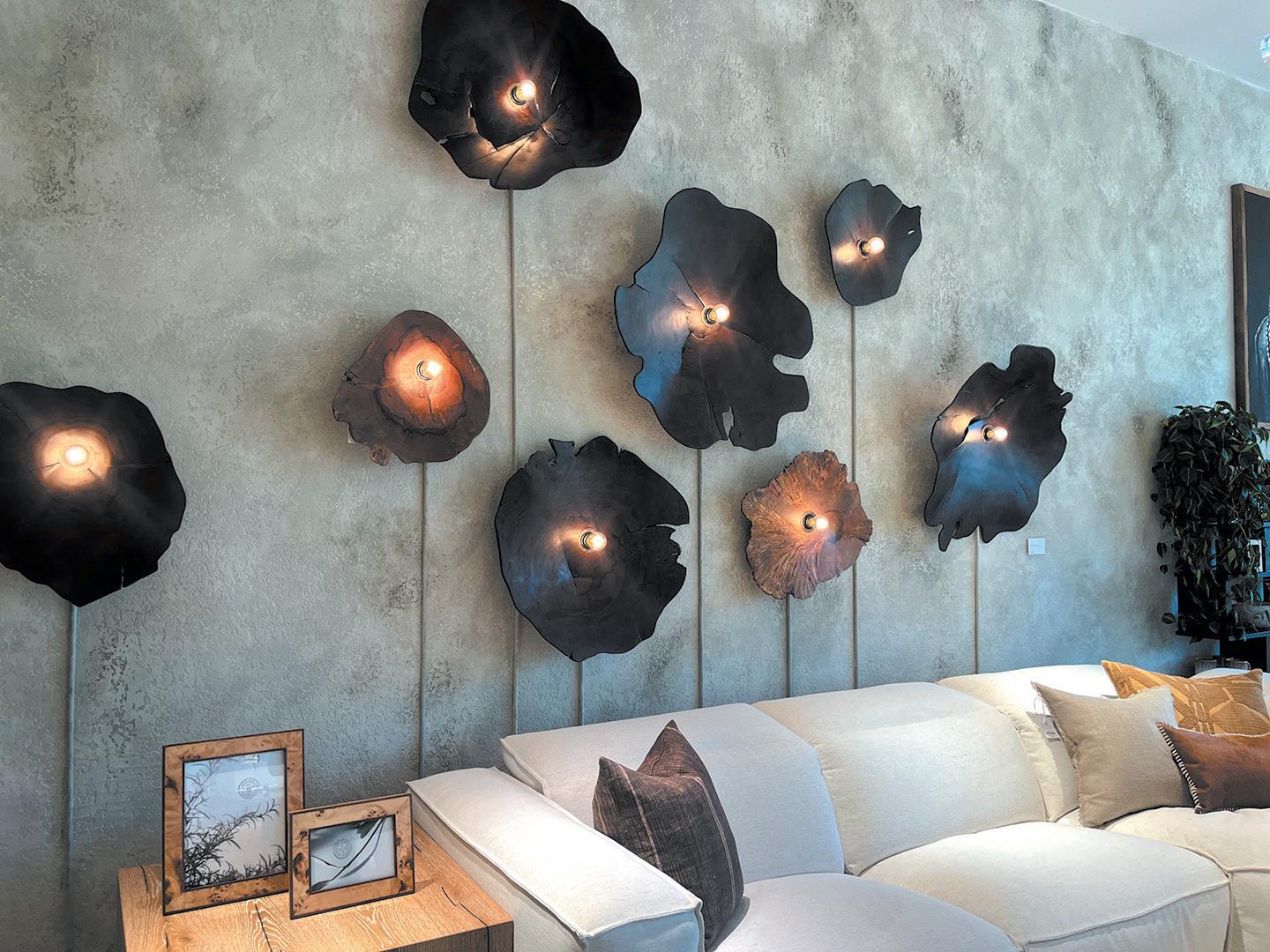
HAND-HEWN wooden Arruga sconces.
on-trend furnishings.” These include the fluttery wooden pendant lamps and sconces in the Arruga line, $1,000 to $1,700 each and handcrafted by a family-owned business in Mexico.
There is a range of price points: sofas run from $1,700 for a tight-back Coburn sofa to $15,000 for an upholstered five-piece sectional from the Gianni collection; hanging lamps start at roughly $220 for the Lanister welded iron mesh pendant, but one can opt for a $7,000 Fiore oval chandelier with a hand-antiqued silver finish over iron and a halo of delicate branches adorned with flower-like crystals. Arhaus also carries
decorative items, on display or online, from a Tibetan longwool lumbar pillow for $130 to travertine wall clocks for $250. The store has beautifully made games — including a $480 natural hide backgammon set with wooden game pieces — and games tables, such as a $6,000 reclaimed wood foosball table.
Wickberg summarizes the appeal of situating Arhaus at The Grove. “We’re proud to serve as the premier home retailer for such an iconic shopping center.”
Arhaus, 189 The Grove Dr., Space D1, at The Grove near the Original Farmers Market northern parking lot, 323920-0012.

By Nona Sue Friedman
Salt & Straw on Larchmont Boulevard was packed on Aug. 29 at 10 a.m. with local residents getting a free scoop of ice cream while milling around with officers from the Wilshire Community Police Station. There was no evidence that it was really morning with all of the ice cream being consumed.
In addition to ice cream, coffee was donated by Starbucks, whose shop is just a few doors down the Boulevard from Salt & Straw. Great White also wanted in on the action and spontaneously offered sweet toasted bread to attendees. At one point, the crowd stretched down three store fronts to the south. It was a morning party on the Boulevard.
The informal get-together allowed residents, officers, detectives and even Capt. Julie Rodriguez of Wilshire LAPD ample time to chat about concerns in the area as well as just putting faces to names and vice versa.
Karla Ricci of Larchmont Village, a new mom to her second daughter, who was 7 days old, said, “The Larchmont Chronicle brought me here, like the good old, normal days. My dad is visiting. He read the paper that was left
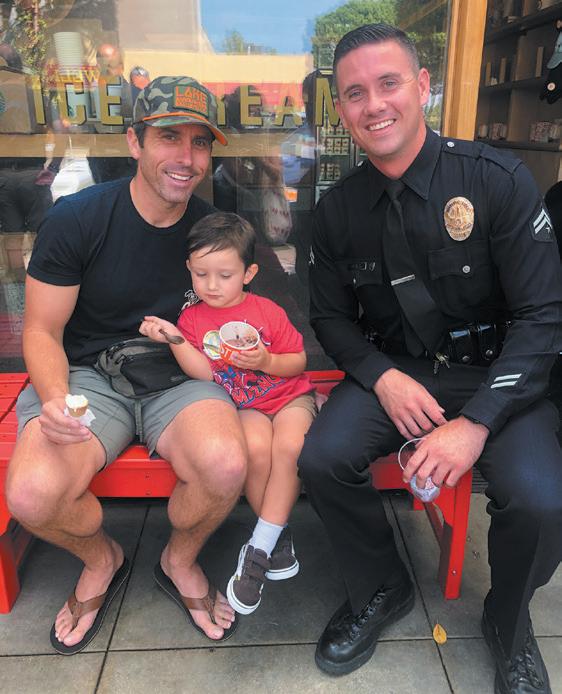
should have someone chosen in the next couple of weeks. With all the paperwork, the position should be filled by the end of October.”
Shuck is one of the many officers applying for the opening. He worked with SLOs at Wilshire his first year after graduating from LAPD Academy 13 years ago. At the time he thought, “This is the coolest job, kind of like a sheriff for the area. You can get coffee with a resident or arrest someone.”
on my doorstep this morning and told me about the event.”
It turned into a family outing.
Marcia Josephy, a 45-year resident of Hancock Park, said, “I wanted to meet the new officer. We need a specialist for the neighborhood.”
She was referring to new interim Senior Lead Officer (SLO) Tyler Shuck.
Many residents expressed relief that Wilshire LAPD finally got permission to permanently fill the SLO position, left vacant after the retirement of officer Dave Cordova. According to Sgt. Wes Sarno, Wilshire Community Relations Officer, the division is in the process of interviewing candidates. “We
Officer Philip Choi, who also was an interim SLO at the beginning of the summer and set the wheels in motion for the ice cream event, is applying for the permanent position as well. He said, “I’m jealous of this community. I wish it was like this where I lived. People are very connected and caring, and the communication is on point. It’s amazing to see it at work.”
Continuing with the spirit of community, Salt & Straw manager Vivana Granados commented, “We are all about community and outreach. It’s important for our company and our founders. We want this store to be a spot for the entire community.”
Seems like they chose the right neighborhood for that.

Rides, games and food for all ages will transform Venice Boulevard in front of the Wilshire Community Police Station, 4861 W. Venice Blvd., into a carnival for the first time in five years. The community-spirited weekend event takes place Fri., Sept. 27, from 5 p.m. until 11 p.m., and continues Sat., Sept. 28, 2 to 11 p.m. and Sun., Sept. 29, 2 to 10 p.m.
In addition to bringing the neighborhood together for a good time, this is an opportunity to support your local police station. Discounted tickets can be purchased at the station through Thurs., Sept. 26. After that, buy tickets at the gate once the event begins. Funds raised primarily support the Wilshire Division Cadet Program for teens 13 to 17 years old. Venice Boulevard will be closed between La Brea Avenue and Rimpau Boulevard for the weekend.

ROBBERIES: A suspect on foot approached, struck and stole property from a victim on the 500 block of South Arden Boulevard. The suspect fled the scene walking southbound on Sept. 6.
During a rideshare, a suspect approached a victim, pointed a handgun and removed property on Sept. 9. The suspect fled the scene but currently is in custody.
BURGLARIES: Suspects entered the rear yard of a home using a chair or ladder on the 5200 block of Rosewood Avenue. They removed property and fled on Sept. 1. Thieves, possibly with keys to the property, gained access to an office in a building on the 400 block of North Larchmont Boulevard. They removed property on Sept. 3.
WILSHIRE DIVISION
Furnished by Interim Senior Lead Officer
Tyler Shuck

213-712-3715
40740@lapd.online
Twitter: @lapdwilshire
Burglars smashed the rear glass door of a home on the 500 block of North Mansfield Avenue and took property on Sept. 6.
OLYMPIC DIVISION
Furnished by Senior Lead Officer
Daniel Chavez

213-793-0709
36304@lapd.online
Instagram: @olympic_slo1
A residence on the 700 block of North Orange Drive was broken into. Suspects removed property and fled on Sept. 12.
By Nona Sue Friedman
Many factors affect how safe residents feel, from the amount of crime in an area to how police officers enforce

laws. Another factor is legislation. And yes, you guessed it, it’s an election year, and one proposition on the ballot could affect law enforcement in our neighborhood, according to law enforcement sources.
Proposition 36 is a citizen’s initiative measure placed on the ballot trying to close loopholes in Proposition 47, which passed in 2014.
According to a 27-year veteran officer of the Los Angeles Police Department (LAPD), “There are too many arrests and immediate releases.” He thinks Prop 36, if passed, could help the situation.
Arguments pro and con may be read at tinyurl.com/3nf97zd9.

Suspects entered the backyard of a home, disabled the electrical box and made a forced entry into the home on the 500 block of South Citrus Avenue, taking property, on Sept. 13.
Suspects smashed the rear glass door and gained entry to a home on the 600 block of Lillian Way on Sept. 13.
GRAND THEFT AUTOS:
All of the four cars stolen this month were recovered.
OLYMPIC DIVISION
BURGLARIES: A resident of a multi-unit building returned home on Sept. 7 at 9:30 p.m. to find the residence in the 5000 block of
Rosewood Avenue completely ransacked.
A suspect unsuccessfully attempted to pry open a window of a multi-unit building on Sept. 8, at 8:45 a.m., on the 5000 block of Rosewood Avenue.
ROBBERY: During a domestic dispute, a suspect attempted to assault a victim, struggled and took the victim’s phone on Sept. 1 at noon near the intersection of Wilton Place and Seventh Street.
GRAND THEFT AUTO: A car was stolen from the 100 block of South St. Andrews Place on Sept. 1 at 6 p.m.
By Nona Sue Friedman
Olympic Community Police Station (LAPD) has a new captain, Brian O’Connor. He took the reins on Sept. 9.
Capt. Aaron Ponce was reassigned after two and a half years at Olympic. Ponce is now Commanding Officer at Mission Division, which covers the northern part of the San Fernando Valley.
Capt. O’Connor told us, “The first two weeks in a new position are always very busy, but this seems like a great place.” He’s settling in and meeting his new staff and the important stakeholders in the district. He met with Larry Guzin, president of the Windsor Square Association, his second week on the job.
On the day the Chronicle spoke to Capt. O’Connor, he had just driven the division, which includes the eastern portions of Windsor Square
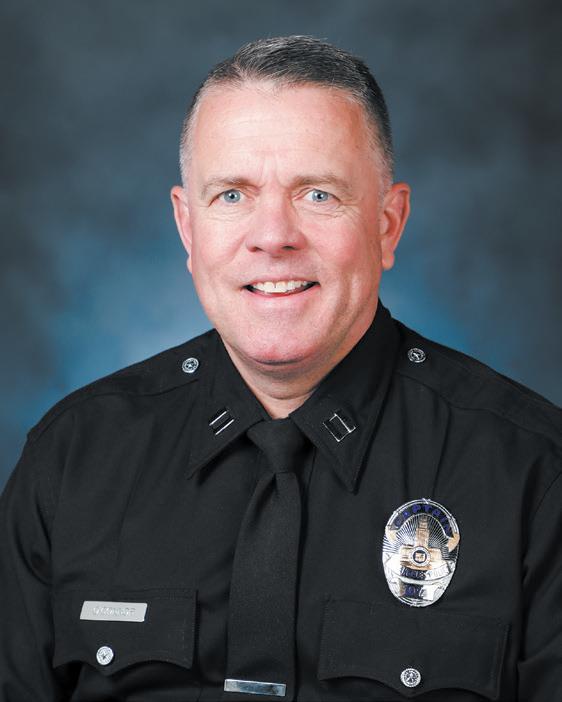
and Larchmont Village, plus all of Wilshire Park and continues east to Hoover Street, including all of the area from Melrose Avenue to the Santa Monica Freeway. He commented, “Love Larchmont, love that shopping district.”
O’Connor started as a police officer in the United States Army Reserve in 1989. Then, in 1992, he joined the North

I recently inherited my late grandmother’s wooden vanity, one of the first items she purchased after moving to the U.S. in 1949. “Is the pouf from the original set?” I asked my uncle, referring to a round, biscuit-like seat upholstered in a pale pink suede next to the dressing table. “The hassock,” he corrected me, “is indeed original.”
A hassock, named from the Old English “hassuc,” meaning “clump of grass,” is actually not so different from a pouf (I soon learned with indignance), or a footstool, or an ottoman, for that matter. More broadly, the word “chair,” traces back to the classical Latin “cathedra,” meaning “a teacher’s or professor’s chair,” from which the word “cathedral” also descends. “Cathedra” evolved from the Greek “kathedra,” a joining of “kata” (or “down”) and “hedra” (meaning “seat, base or face of a geometric solid.”) The latter Greek term makes “chair” a distant cousin of a different
(Continued from Page 14)
Attleboro Police Department in Massachusetts. In 1999 he moved to Los Angeles and joined LAPD. He’s held numerous positions throughout the department, including Watch Commander at both Foothill Division Patrol and Mission Division Patrol, sergeant at West Los Angeles Division and Harbor Division and Commanding Officer at Van Nuys Division Patrol.
In addition to having a Bachelor of Science, he has a Juris Doctorate degree and is a member of the California State Bar.
Welcome to the neighborhood, Capt. O’Connor!


category of three-dimensional objects — “polyhedrons.”
For centuries, having even a rudimentary chair was a mark of status, and proper seats were reserved for chieftains and pharaohs. It’s a notion memorably captured by the 2006 film “Borat,” in a scene where the title character — distinguished by his hyperbolically medieval worldview — checks into a hotel room and is impressed by the amenity of a single chair. Beyond parody, “chairs” do help designate status, and we use the term figuratively to describe a seat of authority as well as the “chairwoman” or “chairman” who occupies it.
During the late 1800s, in the throes of the tuberculosis crisis that enveloped Europe and the Americas, Mark Cook, a New York City office worker stricken with the illness, headed upstate in search of fresh air. He recovered and wrote about the experience in his 1881 book “The Wilderness Cure,” earning the Adirondack region a reputation as a healthful environment in which to treat the ailment. A number of sanatoriums — the name for TB treatment centers — soon opened in the area.
Meanwhile, Thomas Lee, of Westport, New York, began developing a simple yet comfortable outdoor chair from which his family could enjoy views of Lake Champlain behind his summer home. The design he arrived at in 1903 was adapted and patented by Harry C. Bunnell, becoming the “cure chair” of choice for sanatoriums, whose patients would lounge outside for hours in the fresh outdoor air. Called the Adirondack chair today, the wide spread of the chair’s paddle-like armrests was thought to help open up the sitter’s chest, aiding in recuperation.
A chair for chatting
Sixteenth century France saw the emergence of the “caquetoire.” From the French
Word Café by Mara Fisher

word meaning “to gossip,” it was a specialized seat where one may chat with ease. According to one source from 1556, “The ladies of Paris did not hesitate to call ‘caquetoires’ the seats on which once seated, especially around a woman who has just given birth, each one wanted to show that she did not have a frozen tongue.” Designed with comfort in mind, the chair sports a generously sized splayed seat and outward curving arms to accommodate the voluminous
dresses of the era.
A chair for resting one’s petticoats... and flirting
The wide, single-person chairs devised to accommodate the outsize silhouettes of 18th-century Western dress evolved a century later into seats perfectly suited for two. One S-shaped design, called a “tête-à-tête” (French for “head to head”) or “courting bench,” was surely favored by buttoned-up Victorians as its design was conducive to intimate conversation but all but inhibited touching. A simpler, mini-sofa design was immortalized as the “love seat” we know today.
A chair for staying warm English manors of the early 18th century were home to another design — the wingback. The armchair is so named for
its enveloping “wings,” incorporated to shield against chilly drafts and retain the warmth emanating from a nearby fireplace. The seats were often associated with the elderly or sick, as the wings also provided support for a nodding head. Borrowing from France’s Louis XV furniture, some of the chairs sat on curved, satyr-like “cabriole” legs, from the French word meaning “to leap like a goat.” A chair for writing about chairs
For most writers, it’s a sedentary life, and I’m certainly seated more often than not. But in a sick twist of fate, I write to you now from my standing desk. Call it the urge to keep a distance from my subject or to be quite literally “on my toes.” Sometimes the best chair is no chair at all.



